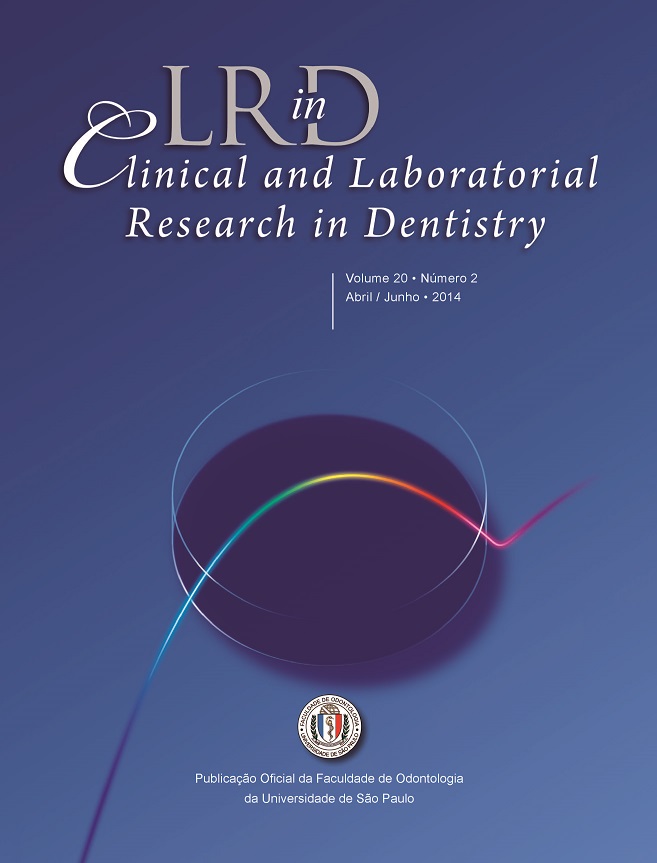Theoretical knowledge versus practical performance in dental sculpting – preliminary study
DOI:
https://doi.org/10.11606/issn.2357-8041.v20i2p82-87Keywords:
Escultura, Ensino, Anatomia DentalAbstract
Conhecer a anatomia dos dentes é de fundamental importância na prática das diversas especialidades Odontológicas. Todas as escolas de Odontologia possuem obrigatoriamente em sua grade curricular uma disciplina responsável pelo ensino da anatomia dental, na qual um conteúdo teórico é transmitido aos alunos para reprodução na escultura em cera. Assim, o objetivo deste estudo foi avaliar se o conteúdo teórico programático está sendo aplicado na escultura prática. Para isso 76 provas teóricas, planejadas sobre a localização das características anatômicas do dente 23, e 76 esculturas em cera (prova prática), foram examinadas individualmente por 2 examinadores pré-calibrados para cada característica selecionada. Os dados foram organizados em tabelas de acordo com as características analisadas e o tipo de exame (teórico ou prático). O teste do qui-quadrado apontou que não houve diferença estatisticamente significativa entre as provas teórica e prática (p≥0.05). A estrutura dental que os alunos mais acertaram em ambas as provas foi o cíngulo (79%) e a de menor porcentagem de acerto na associação das 2 provas foi a bossa palatina (19%). Os achados são baseados somente nos resultados do desempenho dos alunos com relação a identificação e localização das estruturas anatômicas de um dente anterior. Dentro das limitações deste estudo, concluiu-se que, para os dados avaliados, não foi possível observar uma relação entre os conhecimentos teóricos adquiridos e o desempenho prático dos alunosDownloads
References
Bodi LHVD, Turbino ML, Vieira GF. Eficácia do método geométrico no aprendizado da escultura dental no curso de graduação em Odontologia. Revista da ABENO 2007;7(2):112-6.
Obrez A, Briggs C, Buckman J, Goldstein L, Lamb C, Knight WG. Teaching clinically relevant dental anatomy in the dental curriculum: description and assessment of an innovative module. J Dent Educ 2011;75(6):797-804.
Hauser AM, Bowen DM. Primer on preclinical instruction and evaluation. J Dent Educ 2009;73(3):390-8.
Wheeler R. Tooth Form Drawing and Carving; a manual. 2nd ed. Philadelphia & London: W B Saunders Co; 1940. 71 p.
Vieira GF, De Caroli A, Garófalo JC, Matson E. Escultura dental com auxílio do método geométrico (revisão anatômica). 3rd ed. Ribeirão Preto: Ad-Tech Comunicação; 2002. 91 p.
Vieira GF. Atlas de anatomia de dentes permanentes: coroa dental. 1st ed. São Paulo: Ed. Santos; 2007. 121 p.
Siessere S, Vitti M, de Sousa LG, Semprini M, Regalo SC. Educational material of dental anatomy applied to study the morphology of permanent teeth. Braz Dent J 2004;15(3):238-42.
Polyzois I, Claffey N, McDonald A, Hussey D, Quinn F. Can evaluation of a dental procedure at the outset of learning predict later performance at the preclinical level? A pilot study. Eur J Dent Educ 2011;15(2):104-9.
Giuliani M, Lajolo C, Clemente L, Querqui A, Viotti R, Boari A, et al. Is manual dexterity essential in the selection of dental students? Br Dent J 2007;203(3):149-55.
Gal GB, Weiss EI, Gafni N, Ziv A. Preliminary assessment of faculty and student perception of a haptic virtual reality simulator for training dental manual dexterity. J Dent Educ 2011;75(4):496-504.
Mitov G, Dillschneider T, Abed MR, Hohenberg G, Pospiech P. Introducing and evaluating MorphoDent, a Web-based learning program in dental morphology. J Dent Educ 2010;74(10):1133-9.
Broudo M, Walsh C. MEDICOL: online learning in medicine and dentistry. Acad Med 2002;77(9):926-7.
Kilistoff A. A Systematic Technique for Carving Amalgam and Composite Restorations. Oper Dent 2011;36(3):335-9.
Bogacki RE, Best A, Abbey LM. Equivalence study of a dental anatomy computer-assisted learning program. J Dent Educ 2004;68(8):867-71.
Wright EF, Hendricson WD. Evaluation of a 3-D interactive tooth atlas by dental students in dental anatomy and endodontics courses. J Dent Educ 2010;74(2):110-22.
Nance ET, Lanning SK, Gunsolley JC. Dental anatomy carving computer-assisted instruction program: an assessment of student performance and perceptions. J Dent Educ 2009;73(8):972-9.
Divaris K, Barlow PJ, Chendea SA, Cheong WS, Dounis A, Dragan IF, et al. The academic environment: the students' perspective. Eur J Dent Educ 2008;12 (Suppl 1):120-30.
Rosenberg H, Sander M, Posluns J. The effectiveness of computer-aided learning in teaching orthodontics: a review of the literature. Am J Orthod Dentofacial Orthop 2005;127(5):599-605.
Downloads
Published
Issue
Section
License
Authors are requested to send, together with the letter to the Editors, a term of responsibility. Thus, the works submitted for appreciation for publication must be accompanied by a document containing the signature of each of the authors, the model of which is presented as follows:
I/We, _________________________, author(s) of the work entitled_______________, now submitted for the appreciation of Clinical and Laboratorial Research in Dentistry, agree that the authors retain copyright and grant the journal right of first publication with the work simultaneously licensed under a Creative Commons Attribution License that allows others to share the work with an acknowledgement of the work's authorship and initial publication in this journal. Authors are able to enter into separate, additional contractual arrangements for the non-exclusive distribution of the journal's published version of the work (e.g., post it to an institutional repository or publish it in a book), with an acknowledgement of its initial publication in this journal. Authors are permitted and encouraged to post their work online (e.g., in institutional repositories or on their website) prior to and during the submission process, as it can lead to productive exchanges, as well as earlier and greater citation of published work (See The Effect of Open Access).
Date: ____/____/____Signature(s): _______________


